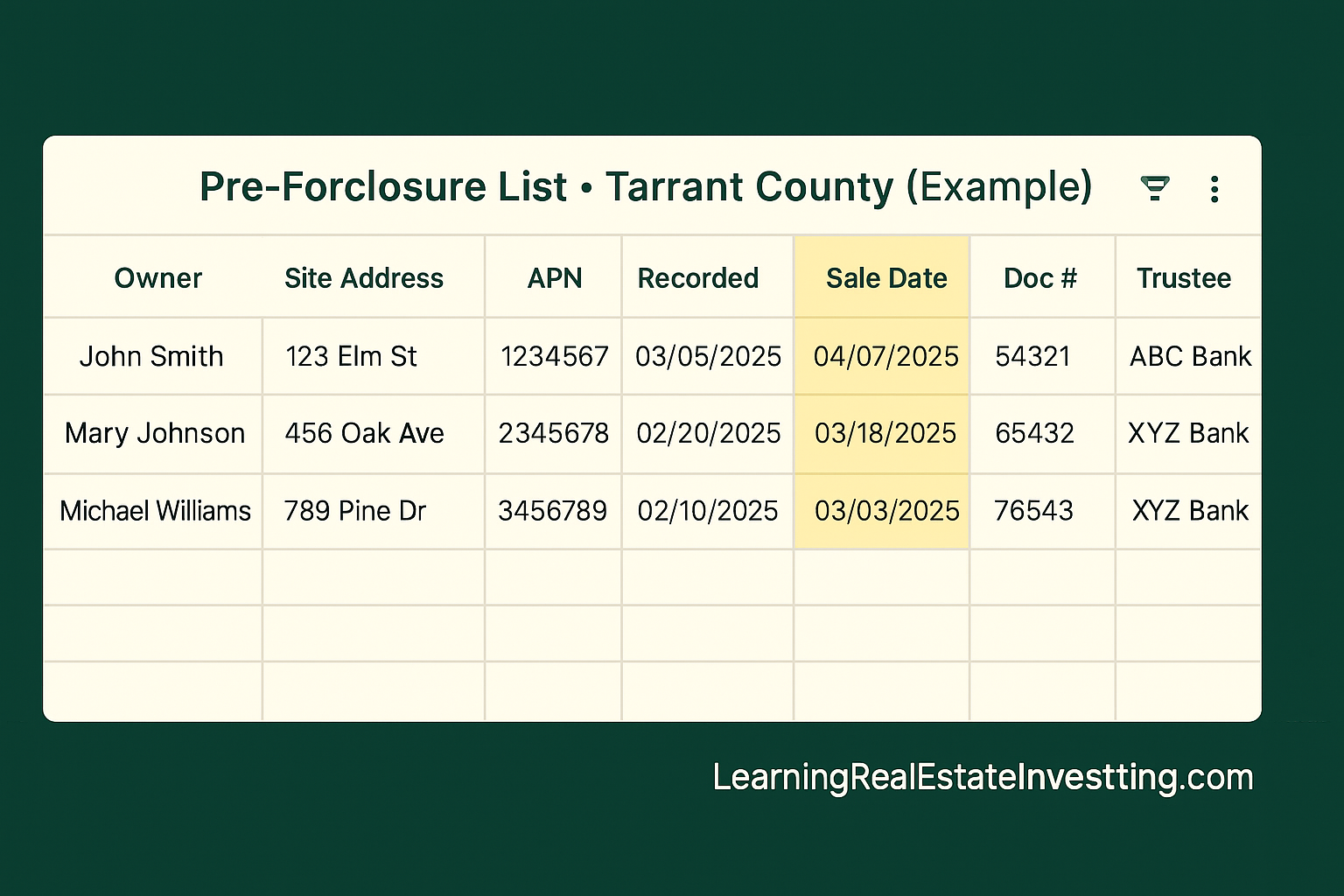How to Pull the Tarrant County Pre-Foreclosure List (Free + Paid Options)
If you’re chasing real deals in Tarrant County, stop guessing and start pulling the actual notices that hit the clerk’s system. Below is the no-fluff, step-by-step to source pre-foreclosures fast, clean your list, and reach sellers without tripping compliance wires.
1) Where the data lives (county + third-party)
Primary (official): Tarrant County posts foreclosure notices and maintains an online Official Records search. Expect “Notice of Trustee’s Sale” and “Notice of Substitute Trustee’s Sale” documents. You’ll filter recent filings (last ~21 days) since Texas sales are the first Tuesday each month and notices must be posted in advance. Use the county’s Real Property search to pull current filings, then build your working sheet (Owner, Site Address, APN, Recorded Date, Doc #, Trustee, Lender, Sale Date, Opening Bid if stated).
- Open the county’s Official Records search portal.
- Select the Real Property database and use Advanced or Document Type filters.
- Filter by document type: Notice of Trustee’s Sale and/or Notice of Substitute Trustee’s Sale.
- Set a date range covering the last 21–30 days.
- Run search → open each notice → capture key fields to your spreadsheet.
Secondary (paid): Third-party tools aggregate pre-foreclosure and auction data. They’re fast for prospecting but can lag the county. Use them to expand coverage or fill gaps; verify against the clerk’s record before outreach.
- Data platforms (pre-foreclosure filters, exports, list building).
- Auction platforms (sale calendars, addresses, basic details).
2) Free sources vs paid providers
Free (official) sources
- County foreclosure notices — pull “Notice of Trustee’s Sale” filings filed with the County Clerk.
- Public postings — monthly sale postings and clerk public notices pages.
- Law library guides — confirm process timing and sale day basics for Texas.
Paid providers (use to speed up)
- Data platforms — pre-foreclosure filters, comps, exports, mail merges.
- Auction calendars — addresses headed to the courthouse steps, with updates and bid links.
Bottom line: Free gets you the most accurate, court-filed records; paid gets you speed and convenience. Use both, but trust the clerk for final verification.
3) Skip-tracing workflow
- Normalize your sheet: Columns for Owner Name(s), Mailing Address, Site Address, APN, Recorded Date, Sale Date, Doc #, Trustee/Lender, Phone/Email (blank for now), Status.
- De-dupe & enrich: Remove duplicates; append phones/emails with your preferred service.
- DNC/TCPA hygiene: Scrub against the National Do Not Call Registry; remove wireless numbers you can’t lawfully message; capture opt-out preferences on first contact.
- Prioritize timing: Sort by Sale Date ascending, then by equity/ARV potential.
4) First 48-hour outreach plan
Goal: establish contact fast, stay respectful, and create a path to a win-win (reinstate, sell, or alternative).
- Hour 0–2: Drop a first-class letter the same day you pull the list. Keep copy calm, plain, and solution-oriented.
- Hour 4–12: One live call attempt during permissible hours. If no answer, leave a normal voicemail (no “ringless” tech).
- Hour 24: Second live call attempt; then a follow-up letter or postcard with a short URL/QR to request a call.
- Hour 36–48: If local and safe, a courteous knock (daylight, visible ID) or a door note with your direct number.
What to say: acknowledge the notice; offer options (sell as-is, buy time with a purchase/leaseback via counsel, connect with a housing counselor, etc.); be specific about next steps and timelines.
5) Compliance notes (read this twice)
- DNC: Scrub consumer numbers against the National Do Not Call Registry and keep a company-specific do-not-call list. Respect opt-out requests immediately.
- TCPA & texting: Marketing texts generally require prior express written consent to one seller at a time. Don’t “spray and pray” SMS at distressed homeowners.
- Caller ID & hours: Show a valid caller ID and call only during permissible hours.
- Disclaimers: You’re not a lawyer; encourage homeowners to consult counsel. Keep your language fair and honest.

Grab the outreach scripts
Short, respectful letters and call frameworks for pre-foreclosure homeowners.
FAQ
Is the list public?
Yes. Notices of sale are recorded with the County Clerk and posted publicly before the monthly auction day. You can view them online and at designated public posting locations.
How often is it updated?
New notices file continuously; plan to pull weekly. Sales occur the first Tuesday each month, so the hottest filings appear 2–3 weeks before that day.
Can I text these homeowners?
Not for marketing without prior express written consent naming your business. Use compliant mail and live calls first; honor all opt-outs.
How do I avoid DNC violations?
Scrub against the National DNC, maintain a company DNC list, show valid caller ID, call within permissible hours, and document consent and opt-outs.
Internal resources:


Leave a Reply